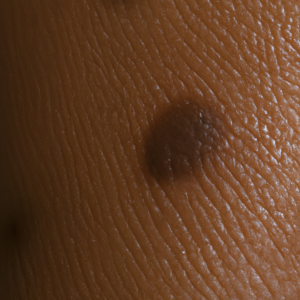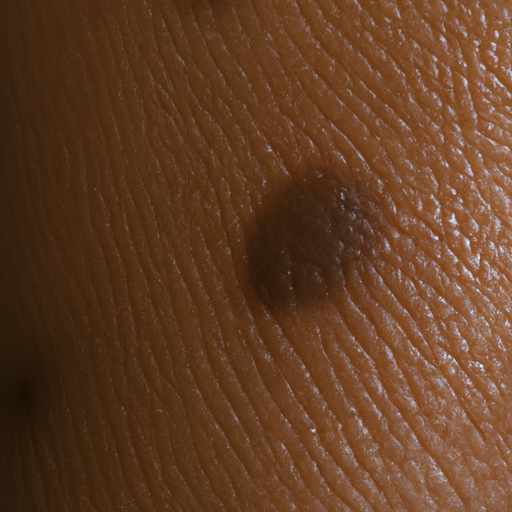What’s the Deal with Lentigo?
Hey, guys! It’s your friendly neighborhood blogger here. Today, I want to chat with you about something that’s been bugging me for a while – lentigo.
Now, I know what some of you are thinking. “What the heck is lentigo?” Well, let me tell you. Lentigo is a fancy medical term for a type of skin discoloration.
It’s like when your skin starts to get those little brown or black spots. Sometimes they’re flat, and sometimes they’re slightly raised. They can be really small or larger in size. Sound familiar?
Don’t worry – you’re not alone. Lentigo is actually a pretty common condition. But let’s go over some of the basics, just so we’re all on the same page.
What in the World Causes Lentigo?
So, you’re one of the many people who noticed some small, flat, brownish spots on their skin and thought: “what in the world is that?”. Chances are, those spots are Lentigo, a type of skin discoloration often confused for freckles.

But what causes Lentigo to appear in the first place? Well, there’s no single answer to that question. A few factors can contribute to the formation of these spots, such as:
- Excessive exposure to sunlight and harmful UV rays – Sun=damage. It’s that simple. If you’re spending hours on end under the sun without proper protection (e.g., sunscreen, protective clothing), you’re risking your skin’s health.
- Aging – As we age, our skin goes through various changes, including reduced collagen levels and decreased melanocyte activity, leading to skin discoloration and age spots.
- Genetics – Sometimes it’s just in your genes. People with fair skin, light eyes, and red or blonde hair are more likely to develop Lentigo.
While these are the main causes, the formation of Lentigo isn’t an exact science. In any case, it’s essential to visit a dermatologist to get an accurate diagnosis and avoid any potential complications.
Ah, Those Pesky Lentigo Symptoms!
Let me tell you, it’s not a fun time dealing with lentigo symptoms. One of the first things you might notice is the appearance of dark spots on your skin. These can be flat or slightly raised and can range in color from light brown to dark black. Sometimes, the affected area might be itchy or feel slightly tender to the touch.
Another symptom to look out for is skin discoloration when exposed to the sun. If you have lentigo, you might notice that the affected area becomes darker in color when exposed to sunlight. This can be a huge pain, especially in the summer months when you want to spend time outdoors.
Oh, and did I mention that lentigo can also cause the affected area to feel dry or scaly? Yup, it’s true. This can be particularly frustrating if you’re someone who already struggles with dry skin.
Finally, if you have lentigo, you might notice that the affected areas don’t tan as easily as the surrounding skin. This can be a dead giveaway that you’re dealing with lentigo and not just regular skin discoloration.
“Diagnosis? Lentigo? No worries!
So, you’re wondering if you have Lentigo. Well, let me tell you, getting a diagnosis for Lentigo is not that difficult. When you visit a dermatologist or a skin specialist, they will examine your skin and ask you about your medical history. They might also perform a biopsy, which is the removal of a small sample of the affected area, to confirm the diagnosis.
But, if you don’t want to go to a dermatologist just yet, you can do a simple test at home. Take a magnifying glass and examine the pigmented spot on your skin. If the Lentigo is benign, the shape, size, and color will not change over time. However, if it is a cancerous mole, it might grow larger, change color, or bleed. In this case, immediately consult a medical professional.
It’s important to remember that Lentigo can also easily be mistaken for other skin conditions. That’s why it’s crucial to do a thorough consultation with a dermatologist to get an accurate diagnosis. Don’t try to self-diagnose, it’s never a good idea.
So, go ahead and visit a dermatologist or a skin specialist. Don’t worry, getting a diagnosis for Lentigo is pretty straightforward. Remember, early diagnosis is key to ensure timely treatment and prevent the condition from worsening.
Treating My Lentigo with Clearskin Pune
After being diagnosed with Lentigo, I knew I needed to find a reliable treatment option. I did some research and came across Clearskin Pune – and I couldn’t be happier with my decision.
At Clearskin Pune, they offer a variety of treatments for Lentigo, including laser therapy and chemical peels. During my consultation, the team of experts evaluated my symptoms and recommended the best treatment plan for me.
One unique aspect of Clearskin Pune is their use of the latest technology and equipment. The laser therapy they used to treat my Lentigo was state-of-the-art, and the results were incredible. Additionally, the staff was extremely friendly and knowledgeable, making me feel at ease throughout the entire process.
Another great thing about Clearskin Pune is their affordable pricing. As someone on a budget, I was relieved to know that I didn’t have to sacrifice quality for cost.
Overall, I highly recommend Clearskin Pune for anyone seeking treatment for their Lentigo. Their expertise, technology, and affordability make them stand out as a top choice in Pune. Don’t hesitate to reach out to them and schedule a consultation – you won’t regret it!
This is the end
Well, folks, that’s all she wrote. After exploring the causes, symptoms, diagnosis, and treatment of Lentigo, it’s time to conclude this blog post. In conclusion, it’s important to understand that Lentigo is a common skin condition that affects many people. It’s characterized by dark pigmented spots on different parts of the body, particularly on areas that are frequently exposed to the sun. The causes of Lentigo can be attributed to prolonged sun exposure, aging, and hereditary factors. As for its symptoms, Lentigo manifests as flat and dark spots. Diagnosis is relatively simple, and it involves a physical examination by a dermatologist. However, if there are any signs of malignancy, a biopsy may be needed to rule out skin cancer. As for treatment, there are various options available. It’s best to consult with a dermatologist to determine the right treatment for your specific case. Clearskin Pune is a highly reputable dermatology clinic that offers professional guidance and customized solutions for a wide range of skin concerns. In summary, Lentigo is a treatable skin condition, and with proper care and attention, you can restore your skin’s health and appearance. So, if you notice any unusual changes in your skin, don’t hesitate to seek medical attention. Your skin is a vital organ, and it deserves the best care possible. Stay safe, healthy, and radiant!
Skin Spot FAQs
How do you treat lentigo on face?
So, you want to know what a lentigo on the skin is and how to treat it? Well, a lentigo is basically a type of pigmented patch or spot on the skin that is usually caused by over-exposure to the sun. It can also occur due to aging, genetics, or hormonal changes. These spots are usually harmless and don’t require any treatment, but some people may want to get them removed for cosmetic reasons.Now, moving on to the second part of the question- how to treat lentigo on the face? There are several options available for treating lentigo, but it’s always recommended to consult a dermatologist before trying anything. One of the most common treatments for lentigo is laser therapy, which involves using a laser to target the pigmented cells and destroy them. Another option is cryotherapy, which involves freezing the spot with liquid nitrogen. Chemical peels and topical creams containing hydroquinone or retinol are also effective in reducing the appearance of lentigo.However, it’s important to note that these treatments may not work for everyone, and they may have some side effects. For example, laser therapy may leave a scar or cause discoloration, while cryotherapy may cause blistering or scarring. Therefore, it’s important to weigh the risks and benefits before undergoing any treatment. Personally, I would suggest trying some home remedies first before opting for any medical treatments. Some effective home remedies for reducing the appearance of lentigo include applying lemon juice, apple cider vinegar, aloe vera gel, or green tea extract on the spot. Massage the area with any of these remedies twice a day for a few weeks, and you might see some improvement. However, if the spot doesn’t go away or becomes larger or darker, then you should consult a dermatologist.
What does a lentigo look like?
So, what is a lentigo on the skin? Well, let me tell you, a lentigo is basically a type of pigmented lesion that can appear on your skin, usually due to sun exposure or aging. It’s a flat and well-defined dark spot that can be round or oval in shape, and ranges in color from light brown to black. It’s a pretty common occurrence, especially in people over 50 years of age.
Now, let’s talk about what a lentigo looks like. As I mentioned earlier, it’s a dark spot on your skin, but it can take on different appearances, depending on where it is on your body. On your face, it may look like a freckle or a small, black or brown, circular or oval patch. On your hands, it may be larger and more irregular in shape. And on your chest or shoulders, it may be more of a light brown color and have a scaly, slightly raised surface.
It’s important to note that while a lentigo is usually harmless, it’s always a good idea to get any new or changing spots on your skin checked out by a dermatologist, just to be safe. They can help determine if it’s a benign lentigo or something more serious, like skin cancer. If it is just a lentigo, there are treatments available, like topical creams or laser therapy, that can help reduce its appearance and prevent it from getting worse.
So, there you have it – a brief rundown on what a lentigo is and what it looks like. If you notice any unusual spots on your skin, don’t hesitate to get them checked out by a professional!
What is lentigo also known as?
Lentigo is a type of spot that appears on the skin. It looks like a small dark or light brown mark that appears on the skin, especially on the face, hands, and arms. It is also known as a liver spot or age spot, as it is more commonly found in older people.
At Clearskin Pune, we see a lot of patients with lentigo. They often come to us concerned about whether the spot is cancerous or not. We advise our patients that lentigo is usually harmless and does not require treatment unless you want it removed for cosmetic reasons. However, if you notice any changes in size, color, or shape, it’s important to seek medical advice as it could be a sign of something more serious.
It’s essential to protect your skin from the sun to avoid developing lentigo. Overexposure to the sun can cause the spots to appear, especially in people with fair skin. So, make sure you wear protective clothing, use sunscreen regularly, and avoid the sun during peak hours.
If you’re unhappy with the appearance of your lentigo, we offer treatments such as cryotherapy, laser therapy, or chemical peels to remove them. However, it’s important to discuss the risks and benefits of these treatments with a dermatologist before undergoing any procedure.
Overall, lentigo is a common and harmless condition that can be managed by protecting your skin from the sun and seeking medical advice if you notice any changes.
